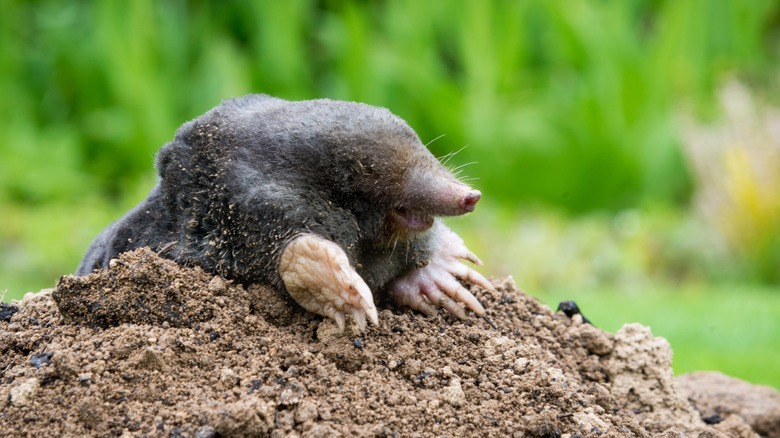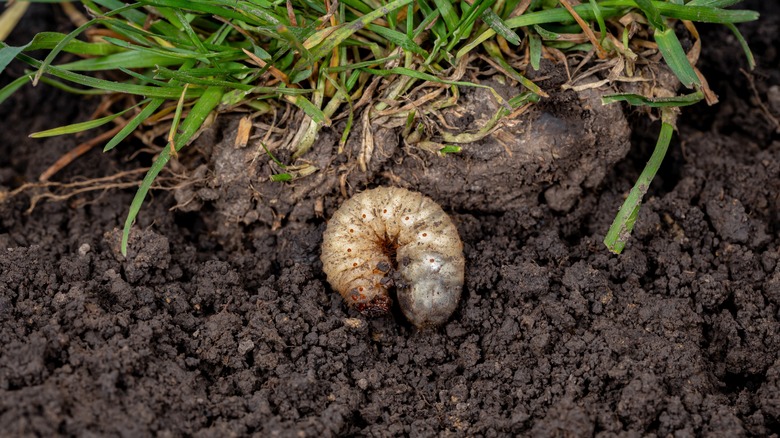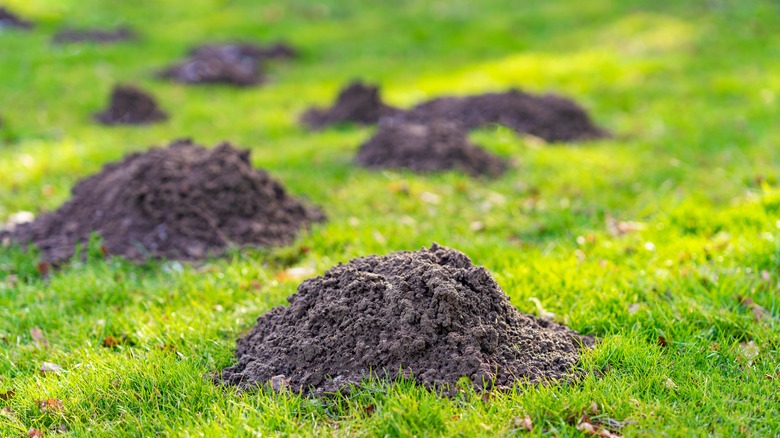Our Entomology Expert Gets To The Bottom Of The Mole Vs. Grub Pest Control Debate
For many budding gardeners, moles and grubs go hand in hand, leading to very familiar yet unsavory sightings of those horrifying dirt mounds. But does executing these wiggly grubs help get rid of moles? Online discourse on the topic has led to much debate among fellow gardeners, but thankfully, entomologist Emma Grace Crumbley of pest control company Mosquito Squad, is here to settle the score. Speaking exclusively to House Digest, she explained that axing grubs may help remove moles from your backyard, but not entirely.
Diving into further detail, she said, "Grubs emerge seasonally during warm months (spring, summer), while the other invertebrates are present in the soil year-round. It's during these periods of emergence that grub activity is the highest, therefore mole activity may also spike." Naturally, this may explain why you're starting to notice havoc unfold in your backyard. And while removing grubs can partially help remedy the mole issue, you'll also want to take other measures to keep things at bay and ensure they don't return with vengeance, per our expert's recommendations.
It's hard to predict where grubs will be
While it may come as a surprise, it turns out grubs can have quite a substantial impact for gardeners or regular folk alike. Diving into further detail, Emma Grace Crumbley explained to House Digest why they can be such an issue. "Beetle grubs are a problematic pest for areas with natural grasses, such as lawns and yards, as well as areas with turf grasses, such as golf courses and sporting fields. Grubs can also create new pest problems as skunks, raccoons, and moles can destroy lawns in their search for grubs to eat. It can be difficult to prevent a grub problem as they can occur anywhere throughout a grassy area, and grub infestations do not take place in the same patches year to year."
This can then lead to moles becoming problematic, creating a domino effect. "Moles are another garden/lawn pest that can devastate grassy areas by tunneling through root systems. Due to their environment, damage, and diet, mole activity has been linked to beetle larvae activity as well." Crumbley added, "Moles are insectivores, meaning their diet consists primarily of insect food. Given their soft body and low mobility and defense systems, grubs make a great food source for moles as they tunnel through the soil." All of this pest activity can be a nightmare for any gardener, especially if you don't know how to deal with it. Thankfully, there are ways you can combat a potential grub-army.
How to treat your soil for moles and grubs
One great way to do this is by ensuring the state of your soil stops moles and grubs from thriving. In an interview exclusive to House Digest, entomology expert Emma Grace Crumbley noted, "Moles are subterranean rodents. This means that the environment they live in and the damage they create all lie below the soil surface, so control measures should aim to target the soil." She added, "Prevention is always the best method. Both grubs and moles enjoy well irrigated, moist soil environments. Reducing irrigation may help discourage moles from foraging in your yard and may reduce grub presence in the future." If you want to take action, she recommended: "[Checking] for areas around your lawn where water may drain to, pool, or create unwanted, overly moist conditions." This will help you keep it as dry as possible and, thus ward off any pesky pests. However, you should keep in mind getting rid of grubs won't necessarily get rid of moles.
If you're unsure if you have any of these wiggly creatures in your garden, a good way to check is by looking out for patchy areas, which is usually a good indicator, in addition to the mole holes. When it comes to axing moles from the area, Crumbly recommended, "For the best and safest results, contact a pest control professional that specializes in wildlife and rodent control." Just make sure the company has a good reputation.


